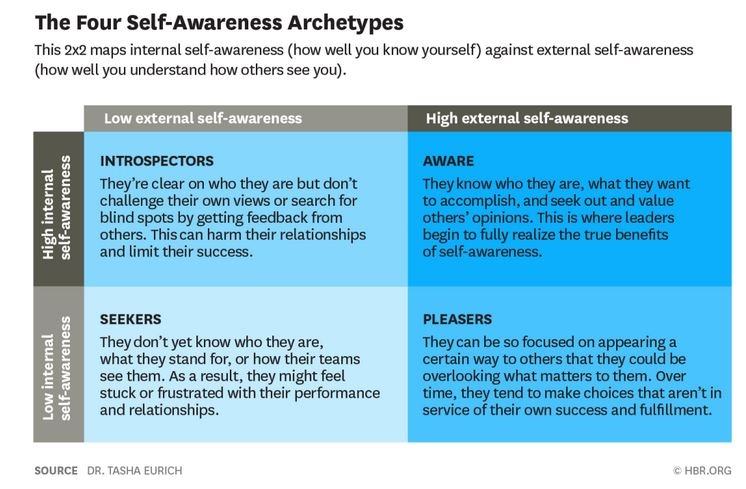“How to See Yourself Clearly: Skip the Introspection Mode
Too much self examination can kill you

“A man wrapped up in himself makes a very small parcel.” ― John Ruskin
Late one night a blind old man was about to go home after visiting a friend. “Please,” he said to his friend, “may I take your lantern with me?”
“Why carry a lantern?” — asked his friend. “You won’t see any better with it.”
“No, perhaps not.” — said the blind one. “But others will see me better, and not bump into me.”
So his friend gave the blind man a bamboo lantern — it had a big candle inside. Off went the blind man and, before he had gone too far, a traveler bumped into him.
The blind man was furious. “Why don’t you look out?” — he stormed. “Haven’t you seen the lantern?”
“Lantern? Well, the candle is OUT!”— replied the traveler.
Introspection is like a lantern — it might provide light, but it doesn’t guarantee seeing.
The blind man didn’t need any light. However, once he depended on it, he became careless and stopped being aware. The old man literally bumped into a stranger.
Being obsessed with self-improvement can have the same effect. The introspection mode — continually examining your thoughts and feelings — can get you stuck. Rather than becoming more self-aware, you lose touch with yourself (and others).
You might be thinking: “Gustavo, you always write about the importance of self-awareness. I don’t get it.” That’s precisely the point of this post, introspection is something different — rehashing thoughts doesn’t generate insights.
To see your true-self clearly you don’t need light, but to increase self-awareness. That’s the path for personal growth.
Too Much Introspection Can Kill You
“The more powerful and original a mind, the more it will incline towards the religion of solitude.” — Aldous Huxley
Thinking doesn’t mean knowledge.
Contrary to popular belief, people who score high on self-reflection are more stressed, anxious, and less satisfied with their work and personal relationships. They are more self-absorbed and feel less in control of their lives, according to research by organizational psychologist Tasha Eurich and team.
Thinking about yourself is not correlated with knowing yourself.
Australian Psychologist Anthony Grant discovered that the process of self-reflection and insights are logically independent. You may spend considerable time doing introspection without necessarily gaining insight.
Constantly inspecting your thoughts, feelings, and behaviors doesn’t mean you understand them.
Drawing a comparison between introspection and meditation can shed some light. Introspection is of the thinking realm; meditation is of the witnessing realm.
Introspection involves thinking, categorizing, labeling, analyzing — you are evaluating your thoughts and emotions. Meditation is about being aware of what you are doing and just observe — you contemplate your thoughts without judging them.
The Introspection Mode Trap
“The problem with introspection is that it has no end.” ― Philip K. Dick
Self-reflection is not wrong, how most people do it is.
Many people approach self-improvement with a rigid mindset — they expect to find a perfect answer. But mindfulness is not about having the right formula but about appreciating the journey.
Jon Kabat-Zinn said: “Mindfulness means paying attention in a particular way; on purpose, in the present moment, and non-judgmentally.”
Mindfulness is the practice of noticing the degree in which we are identified with our thoughts and beliefs. It’s creating space for:
-Awareness, not thinking
-An attitude of openness and curiosity, not judging
-Flexibility of attention, not resisting
When you fall into the introspection trap, you become careless as it happened to the blind man. By becoming dependent on the lamp, you lose touch with yourself.
Here’s how the introspection trap:
1. You let self-doubt take over
Your mind is fragile. Too much thinking invites self-doubt to take over. When you lose touch with yourself, you stop appreciating what you are worth. What is essential is invisible to reason.
Self-doubt erodes confidence. And you start feeling sorry for yourself. Self-pity is an exaggerated sense of sorrow when you become a victim of your inner-critic. The quest for finding who you are can turn you upside down.
2. You rehash memories over and over
Rumination is an ineffective coping behavior. When we cannot accept reality, we repeatedly chewing sad experiences or conversations, is like getting stuck in the sand.
Rehashing memories is like watching the same movie over and over. You know the storyline by heart, pretending a different ending is useless. Spinning a story will get you stuck without providing any insights.
3. You are obsessed with finding ‘the’ truth
Most people do soul searching to find the perfect answer. However, there’s no absolute truth. We all have different challenges — there’s no such a thing as a perfect solution that addresses everyone’s questions.
Trying to find ‘the’ truth can blind us. You stop observing; no answer will ever be good enough. It’s better to be kind to yourself than to be right. Be compassionate with yourself. What seems right today might not work for you tomorrow.
Your questions will change, so will your answers.
4. Your thoughts can eat you alive
Having thoughts is normal. But when you fall into the introspection mode trap, you let your thoughts take over. Too much thinking can get you distracted. Or, even worse, they can cloud your mind.
Your thoughts are like wolves that live inside of you, as I wrote here. If you don’t tame them, they can eat you alive. You need to neutralize your thoughts to avoid turning introspection turn into a suffering game.
5. You have a perfectionist mindset
Perfectionism is the enemy of change. When your standard is too high, nothing you think or do will be enough. Instead of helping you uncover insights, introspection feeds your judgmental mind.
Self-reflection without compassion is torture — it’s your judgmental self on steroids. Constantly trying to over-perform triggers the fear of making mistakes and underperform. Reflect to improve, not to become perfect.
Self-Awareness Is Not Just about You
“Self is a sea boundless and measureless.” ― Kahlil Gibran
To know yourself is to accept yourself.
Self-awareness requires observing and accepting who you are — not who you should or shouldn’t be. Acceptance is embracing every part of your self, not just the nice ones.
Thinking about yourself isn’t necessarily correlated with knowing yourself. It can sometimes create the opposite effect: the more time you spend in introspective mode, the less self-aware you become.
You can spend a whole weekend doing introspection and, come Monday, you won’t have improved your self-knowledge.
Self-awareness is not just a nice to have. People with high self-awareness are more confident and creative, communicate more effectively and build stronger relationships, as Tasha Eurich explains in this HBR article.
To increase your self-awareness you need to look outside, not just inside.
Focusing too much on yourself is a trap. You stop noticing others as it happened to the old man. He wanted the lamp to make him visible to others but forgot that people don’t see in us what we expect.
People who score high in self-awareness (‘Aware‘) know themselves well and also understand how others see them.

Conversely, ‘Introspectors‘ lack external self-awareness. They are unaware of their blindspots — they don’t know what they don’t know. Looking for external feedback is critical to developing external self-awareness.
‘Pleasers‘ are focused on external perception. They care so much about what others think of them that they are not authentic. They lost touch with themselves and don’t do much about it. Instead of seeking fulfillment, they the masks others expect from them, as I wrote here.
‘Seekers‘ are lost souls. They lack clarity on who they are or what they stand for. They are also clueless about how others perceive them. Being a ‘Seeker‘ can be a temporary or permanent stage. We all lose clarity of who we are from time to time. Some people simply decide not to do anything about it.
This matrix is helpful to assess of where you are and what you need to work on. However, life cannot be lived through the eyes of a 2×2 graph.
Don’t get stuck if you fall into a “less sexy” quadrant.
Remember, put your perfectionist mind aside.
The Path of The Self Aware Person
“Knowing yourself is the beginning of all wisdom.” ― Aristotle
Developing self-awareness is not a goal; it’s the purpose of your existence. We spend our whole life understanding who we are.
Being obsessed with understanding your inner-self can get you stuck.
You are mutable. The one you are today is not the same you were ten years ago. Knowing yourself requires letting go of who you used to be too. Or the choices you made — what you added and subtracted to your life.
Understand your personal evolution. Write down all the things that once defined who you were, but are no longer part of you. Reflect. We believe that stuff defines us, yet get rid of many beliefs, behaviors or objects throughout our lives and continue to be who we are.
Increasing self-awareness is not just about how well you know yourself, but how others see you.
Ask for feedback. What are you good at? What makes you a difficult person? Why people like you? Why some people feel uncomfortable with you? Write your answers. Ask several people to answer the question. Compare notes. Learn from how other people see you.
Reflect without being judgmental. Practice meditation. Observe your thoughts and call them “thinking.” Don’t label them. Don’t categorize your ideas into right or wrong. You are the collection of all your thoughts.
Spend time reconnecting with the world around you. You are who you know. You are how other people see you. You are part of an abundant universe. We are all interconnected. Your identity influences more than your own behaviors.
Self-awareness makes you more confident. You no longer need a lamp to make you visible to others.”
by Gustavo Razzetti How to See Yourself Clearly: Skip the Introspection Mode